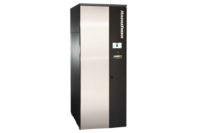Every aspect of HVAC systems grows smarter all the time. A.O. Smith Corp. has been promoting the connected features of its name-brand water heaters, as well as its Lochinvar offerings. The connectivity improves both peace of mind and system efficiency.
Connected features have come a long way. Matt Schulz, senior manager of commercial new product development at A.O. Smith, said the early connected features on the company’s products were for sending alerts. Schulz said it has evolved into much more than that.
A.O. Smith now gives users complete control and visibility into their water heating through an app. This is especially important for restaurant facility managers, as they are consolidating and starting to oversee locations in a multi-state areas, Schulz said. He said the A.O. Smith app actually showed the restaurants closing down and reopening through the pandemic.
The biggest issue for restaurants is controlling costs. Schulz said his company’s system allows restaurant management to track hot water usage by the hour. One common problem for restaurants is when employees keep hot water running during busy periods. Restaurant manager can address this with training if they see it.
“There are definitely ways you can use the system to detect if there is energy waste taking place and then you can address that on a site-specific basis,” Schulz said.
Predicting Failures
The A.O. Smith system also helps in the other direction. Through intelligent demand response, the system tells users when they need hot water the most and ensures they get it.
A connected system also helps control insurance costs. The connected system monitors for leaks and sends alerts if one is detected. Schulz said the water heater can actually find leaks throughout the piping due to its centrality. Water damage is the main cause of insurance claims, and some insurers offer a discount for leak-prevention systems.
The next step is predicting failures, Schulz said. Traditional maintenance is a sort of guessing game based on the system’s years in service. Schulz said contractors will eventually determine that based on its actual performance.
Right now, some contractors are seeking the building manager’s permission to have alerts sent directly to them. This allows for better dispatching, with the right technicians showing up with the right parts. Schulz said sometimes they fix a problem before a customer even knows about it.
“They’re using it to manage their flock of water heaters,” he said.
Connected systems produce massive amounts of data. In fact, controlling the flow of data is becoming increasingly important, said Robert Wiseman, hydronics product manager for Lochinvar. Wiseman said the company tries to keep everything simple so contractors and other users can focus on the data that improves combustion efficiency for Lochinvar’s boilers.
“That’s really the key,” Wiseman said. “Find the ones that make the most impact and determine what you need to do to pivot and adjust to make the unit optimal.”
Hydronics Product Manager, Lochinvar
Adapting to Current Conditions
Some of today’s connected boilers adapt to environmental changes. Earlier this year, Lochinvar launched the Crest with Hellcat combustion technology. They track weather shifts and altitude changes. This allows the O2 sensor to determine if it’s hitting its target for combustion. Wiseman said if a boiler ships from Lochinvar’s Nashville factory to a location in Breckenridge, Colorado, the system takes all these changes into account.
Despite the sophistication of these units, Lochinvar’s designers worked to make the equipment easy to use, Wiseman said. The goal is for anyone at any skill level to perform the startup for these boilers. There’s only one mechanical step. That’s on the gas valve. The rest is all done on the screen.
Other parts are designed for easy access. A technician can remove the connector to work on and then plug it right back into the unit. A personality key allows contractors to use generic boards and retain the boiler’s programming.
“We’ve done as much as we can to make it easier for the contractor and the client so that from startup through the lifetime of the unit, it’s as quick and easy as possible to work with this product,” Wiseman said.
Future units might not even require a screen, Schulz said. Technicians will be able to access the units on a smartphone or tablet via a Bluetooth connection.
Gaining Access to Wi-Fi
The biggest challenge for connectivity now is gaining Wi-Fi access at each location, Schulz said. He said A.O. Smith is working with its contractors to develop better ways to educate property owners about the advantages of providing access. The company also offers a white paper that explains the security protocols it uses.
The ultimate goal is integrating into the overall ecosystem in which the boilers and water heaters are installed. This means communicating with other machines such as variable-speed heat pumps and smart thermostats.
“What else does the boiler need to talk to in that system to maximize everything?” Wiseman said. “People want these high-efficiency products, but they need to understand that the system is what ultimately drives it.”







